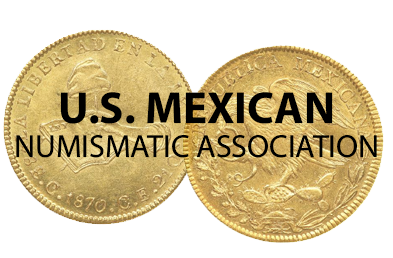Ten centavos coins (1905-1980)
These were made in seven basic types
Type 1 - .800
Type 2 – Little .800
Type 3 – Large bronze
Type 4 - .720
Type 5 – Aztec Calendar
Type 6 – Juárez
Type 7 – Ear of corn (Mazorca)
Type 1 - .800
These were authorised by the Ley Monetaria of 25 March 1905 and the decree of 5 April 1905.
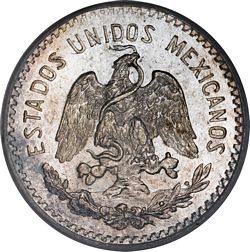
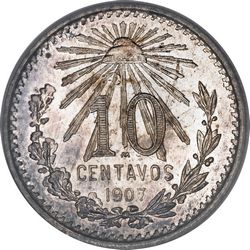
KM-428 1907 10c
These were composed of 80% silver and 20$ copper, had a diameter of 18 mm and a weight of 2.5 g.
| Year | Mintage | |
| 1905 | 3,920,000 | |
| 1906 | 8,410,000 | |
| 1907 | 5,950,000 | 7 over 6 |
| 1909 | 2,820,000 | |
| 1910 | ||
| 1911 | 25,950,000 | |
| 1912 | 1,350,000 | |
| 1913 | 1,990,000 | |
| 1914 | 2,119,000 |
Overdate
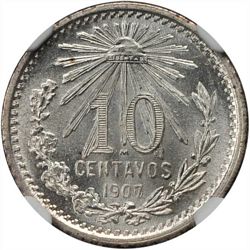
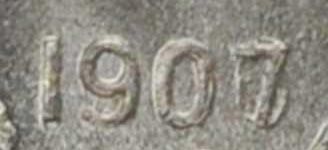
KM-428 1907 10c 7 over 6 (Stack’s Bowers ANA auction, 7 August 2017, lot 22920)
Type 2 – Little .800
On 13 November 1918 Venustiano Carranza reduced the silver content of Mexico’s coins. The reason given in his decreeDiario Oficial, 14 November 1918 were that
(a) as a result of the rise in the global price of silver, the pesos fuertes had long since been driven out from circulation, and the functions of the fractional silver coinage had been hindered by their increasing tendency to disappear;
(b) this was due to unavoidable economic causes, and so the government was unable to prevent the disappearance of the fractional coinage. The remedy was, therefore, to reduce the quantity of pure silver contained in the fractional coin in such a way that there was no inducement to export, recast or simply hide This was all the more acceptable as the fractional coinage had only a representative value, as an auxiliary to the gold coins, that were the basis of the monetary system.
(c) that, since the old silver pesos had disappeared from circulation for some time, there was no longer any reason to consider them as part of the monetary system; and that, since it was desirable to fractional coins worth one peso, it was necessary to demonetize the old silver pesos, thus completing and consolidating the monetary regime established on 25 March 1905, through the country's definitive entry into gold monometallism.
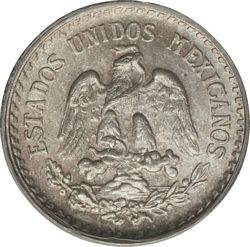
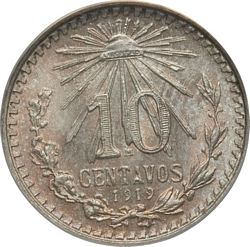
KM-429 1919 10c
These were like Type 1, but 3 mm smaller in diameter and weighed 1.8125 g. Mintage was 8,360,000 in 1919.
When Plutarco Calles authorised the new 10c coin in 1925, he also decreed that the silver 10c, 20c, 59c and $1 coins created by the 13 November 1918 law should be legal tender up to the end of 1925Diario Oficial de la Federación, Tomo XXX, Núm. 3, 6 May 1925.
Type 3 – Large bronze
On 27 October 1919 Venustiano Carranza noted that the continuing rise in the price of silver threatened the disappearance of the one-peso, fifty-, twenty-, and ten-centavo coins created by the previous year’s law, and that the government needed to ensure a supply of such coinage to maintain daily commercial transactions, and so issued a new decree, altering the composition of the 20c, 50c and $1 coins and introducing a new bronze 10c pieceDiario Oficial, 31 October 1919.
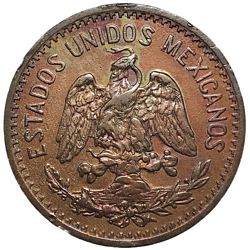
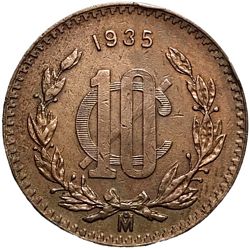
KM-430 1935 10c
These were composed of 95% copper, 2.5% tin and 2.5% zinc. They had a diameter of 30,5 mm and weight of 12 g.
| Year | Mintage | |
| 1919 | 1,232,000 | |
| 1920 | 6,612,000 | |
| 1921 | 2,255,000 | |
| 1935 | 5,970,000 |
When Plutarco Calles authorised the new 10c coin in 1925, he also decreed that the bronze 10c and 20c coins, created by the 27 October 1919 and 7 January 1920 laws respectively, should be legal tender up to the end of 1925Diario Oficial de la Federación, Tomo XXX, Núm. 3, 6 May 1925. However in 1935, when the high price of silver caused the disappearance of silver coins, Mexico again had to revert to producing these bronze coins.
Type 4 - .720, Monogram
In 1925 Plutaro Calles deemed it convenient to uniform the silver coinage and to withdraw the bronze coins in existence and so, on 29 April, authorised a new 10c coinDiario Oficial de la Federación, Tomo XXX, Núm. 3, 6 May 1925.
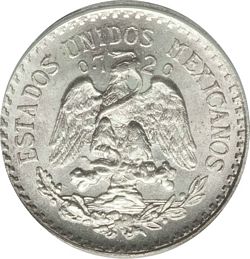
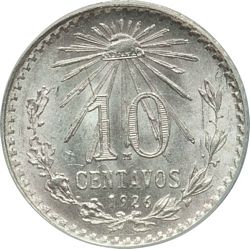
KM-431 1926 10c
These were the same as Type 2, but with reduced silver content (72% silver and 28% copper. They hada a diameter of 15 mm and weight of 1.666 g.
| Year | Mintage | |
| 1925 | 5,350,000 | |
| 1926 | 2,650,000 | |
| 1927 | 2,810,000 | |
| 1928 | 5,270,000 | |
| 1930 | 2,000,000 | |
| 1933 | 5,000,000 | |
| 1934 | 8,000,000 | |
| 1935 | 3,500,000 |
Type 5 – Aztec Calendar
On 26 March 1936 , because of a new high in the price of silver, Lázaro Cárdenas authorises new cupronickel 5c and 10c coinsDiario Oficial, Tomo XCVI, Núm. 3, 6 May 1936.
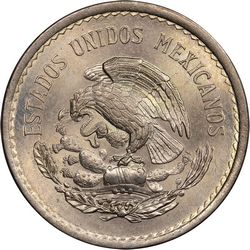
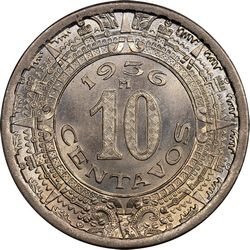
KM-432 1956 10c
These were designed by Manuel Luna Negrete. They were composed of 80% copper and 20% nickel, had a diameter of 23.5 mm and weight of 5.5 g.
These were the first cupronickel coins that the Mexico City mint jad produced and Francisco Valdés, its director, reported "... the manufacture of the aforementioned coins... caused a problem in the Foundry, having to melt a new alloy that was somewhat difficult to obtain in good conditions of homogeneity and malleability".
Minting of these coins was suspended because of the high price of metal during the Second World War.
| Year | Mintage | |
| 1936 | 33,030,000 | |
| 1937 | 3,000,000 | |
| 1938 | 3,650,000 | |
| 1939 | 6,920,000 | |
| 1940 | 12,300,000 | |
| 1942 | 14,380,000 | |
| 1945 | 9,557,500 | |
| 1946 | 46,230,000 |
Type 6 – Juárez
On 13 September 1955 Adolfo Ruiz Cortines issued a decree giving the characteristics of new coins of 1c, 5c, 10c, 20c, 50c $1, $5 and $10Diario Oficial, 15 September 1955.
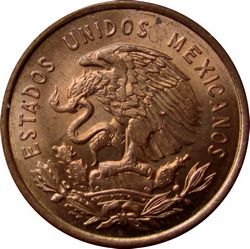
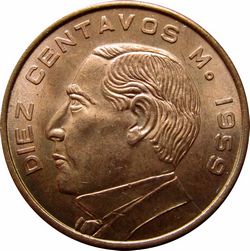
KM-433 1959 10c
These were composed of 95% copper and 5% zinc, had a diameter of 23.5 mm and a weight of 5.5 g.
"One of the means used by the government to neutralize the effect of increases in circulation on prices was the issuance of coins of ten and five pesos whose face value was equal to their intrinsic value, in order to stimulate this traditional form of saving. These coins were created by decree of September 13, 1955." José Manuel Sobrino, La Moneda Mexicana, Su Historia, 1972. So the 1955 coin was minted for a very short period. hence the lower mintage.
| Year | Mintage | |
| 1955 | 1,817,500 | |
| 1956 | 5,255,000 | |
| 1957 | 11,925,000 | |
| 1959 | 26,140,000 | |
| 1966 | 5,872,000 | |
| 1967 | 32,317,500 |
Type 7 – Ear of corn (Mazorca)
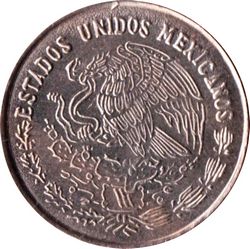
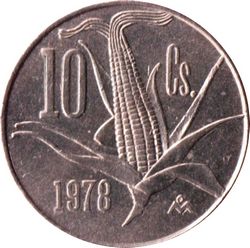
KM-434 1978 10c
These were composed of 75% copper and 25% zinc, had a diameter of 15 mm and weight of 1.485 g.
There are a wide range of varieties for the ear of corn. The corn can have five or six rows of kernals, and the stem style can vary in length, thickness and sharpness.
| Year | Mintage | |
| 1974 | 6,000,000 | 6 rows, sharp |
| 1975 | 5,550,000 | 5 rows, Sharp |
| 1976 | 7,680,000 | 5 rows, Sharp |
| 1977 | 144,650,000 | 5 rows, Thin and 6 rows, Blunt/Thick |
| 1978 | 271,870,000 | 6 rows, Blunt/Thick and 5 rows, Long/Thin |
| 1979 | 375,660,000 | 5 rows, Long/Thin and 6 rows, Long/Thin |
| 1980 | 21,290,000 | 6 rows, Long/Blunt, 80 over 79 |
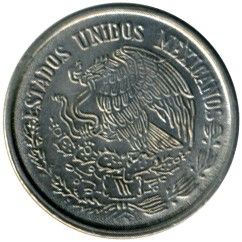
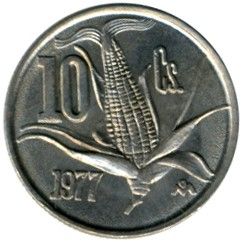
KM-434 10c 1977
